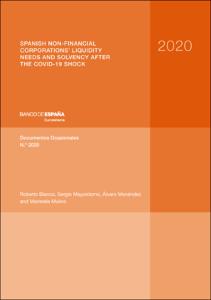Spanish non-financial corporations’ liquidity needs and solvency after the COVID-19 shock
Authors
Issue Date
31-Jul-2020
Physical description
29 p.
Abstract
La epidemia de Covid-19 está teniendo un impacto negativo sin precedentes sobre la actividad económica y, en particular, sobre los ingresos de las empresas, provocando que en algunos casos estos sean insuficientes para hacer frente a los pagos comprometidos. En este documento se presentan los resultados de un ejercicio de simulación de las necesidades de liquidez de las empresas no financieras españolas, para los cuatro trimestres de este año, derivadas tanto de los posibles déficits generados por la evolución de la actividad de explotación como de las inversiones en activos fijos y los pagos asociados a las amortizaciones de deuda. De acuerdo con los resultados, dichas necesidades de liquidez podrían superar los 230 mm de euros entre abril y diciembre. Se estima que, a través de los programas de avales públicos para los créditos a las empresas, podrían cubrirse cerca de las tres cuartas partes de dicho déficit. Para financiar el resto, las empresas podrían utilizar sus colchones de liquidez o recurrir a nueva deuda sin avalar. En este sentido, hay que tener en cuenta que, durante los últimos meses, las compañías con un mejor acceso al crédito han conseguido captar un volumen elevado de fondos sin recurrir a garantías públicas. Por otra parte, a pesar de la caída sin precedentes de la facturación empresarial, un porcentaje no desdeñable de empresas (en torno a un 40?%) habrían podido hacer frente a esta situación sin registrar déficit de liquidez ni experimentar un deterioro de su situación patrimonial. No obstante, en el resto de las compañías el retroceso de la actividad habría llevado a elevar significativamente los niveles de vulnerabilidad financiera, haciéndolo con mayor intensidad dentro del segmento de las pymes y, especialmente, entre las empresas de los sectores más afectados por la pandemia, como los de turismo y ocio, vehículos de motor, y transporte y almacenamiento.
The COVID-19 pandemic is exerting an unprecedented adverse impact on economic activity and, in particular, on firms’ income. In some cases this means firms’ income is insufficient to meet payments to which they have committed. This article presents the results of an exercise simulating Spanish non-financial corporations’ liquidity needs for the four quarters of this year. The needs derive both from the possible shortfalls caused by developments in operating activity and from investments in fixed assets and payments associated with debt repayment. According to the results, these liquidity needs, between April and December, might exceed €230 billion. It is estimated that, through the public guarantee programmes for lending to firms, almost three-quarters of this shortfall might be covered. To finance the remainder, companies could use their liquidity buffers and/or resort to new unsecured debt. In this respect, it should be borne in mind that, in recent months, firms with better access to credit have managed to raise a high volume of funds without resorting to public guarantees. Further, despite the unprecedented fall in business turnover, a significant percentage of companies (around 40%) is estimated to have been able to withstand this situation without posting a liquidity shortfall or undergoing a downturn in their financial position. However, at the remaining companies, the fall-off in activity has led to significant increases in their level of financial vulnerability, doing so more sharply within the SME segment and especially among the firms in the sectors most affected by the pandemic, such as tourism and leisure, motor vehicles, and transport and storage.
The COVID-19 pandemic is exerting an unprecedented adverse impact on economic activity and, in particular, on firms’ income. In some cases this means firms’ income is insufficient to meet payments to which they have committed. This article presents the results of an exercise simulating Spanish non-financial corporations’ liquidity needs for the four quarters of this year. The needs derive both from the possible shortfalls caused by developments in operating activity and from investments in fixed assets and payments associated with debt repayment. According to the results, these liquidity needs, between April and December, might exceed €230 billion. It is estimated that, through the public guarantee programmes for lending to firms, almost three-quarters of this shortfall might be covered. To finance the remainder, companies could use their liquidity buffers and/or resort to new unsecured debt. In this respect, it should be borne in mind that, in recent months, firms with better access to credit have managed to raise a high volume of funds without resorting to public guarantees. Further, despite the unprecedented fall in business turnover, a significant percentage of companies (around 40%) is estimated to have been able to withstand this situation without posting a liquidity shortfall or undergoing a downturn in their financial position. However, at the remaining companies, the fall-off in activity has led to significant increases in their level of financial vulnerability, doing so more sharply within the SME segment and especially among the firms in the sectors most affected by the pandemic, such as tourism and leisure, motor vehicles, and transport and storage.
Publish on
Documentos Ocasionales / Banco de España, 2020
Other versions
Subjects
Covid-19; Necesidades de liquidez de las empresas; Crédito; Avales; Riesgo de insolvencia; COVID-19; Firms’ liquidity needs; Credit; Guarantees; Insolvency risk; Créditos; Instituciones financieras no bancarias; Financiación de la empresa; España
Appears in Collections:












